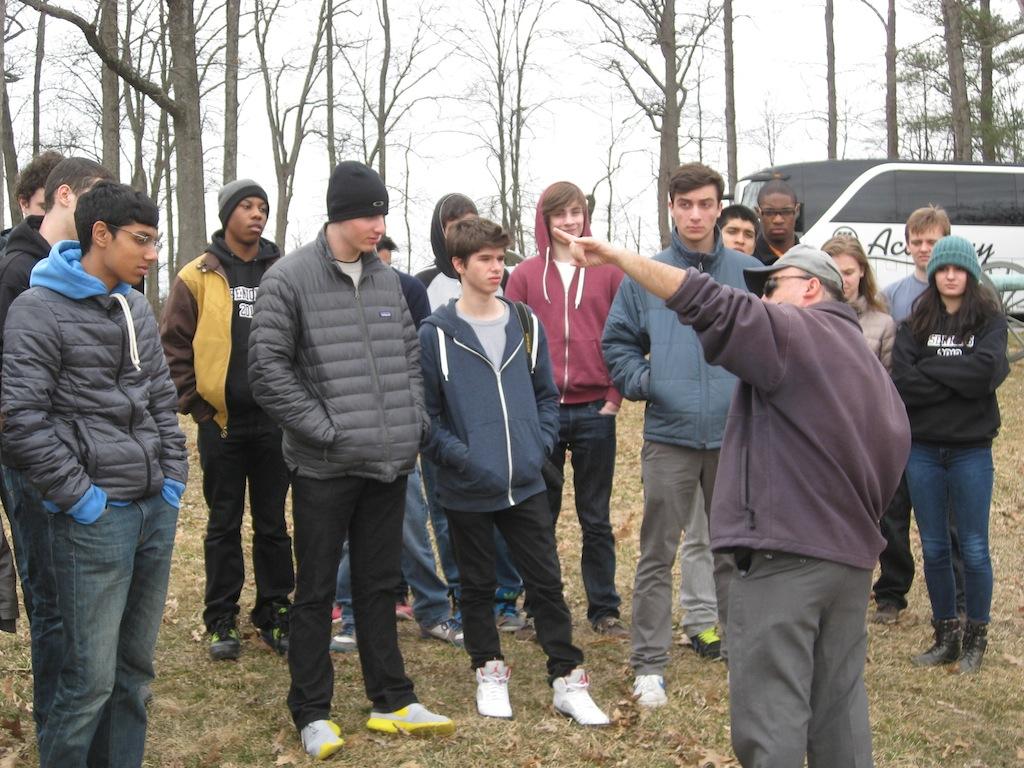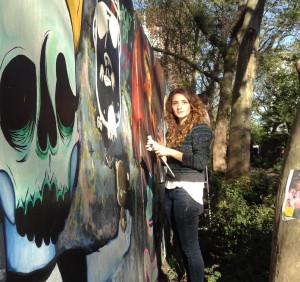This year a unique program was instituted at the Berkeley Carroll School called The Spring Intensives Program. Students were asked to choose a course they were interested in taking from a list of nearly twenty courses, and then took that class exclusively, five days a week seven hours a day, for two weeks in March. There were a wide range of topics, ranging from courses on Neuropsychology and the Construction of Gender to courses on the Battle of Gettysburg and the Beat Generation. (There is a complete list of the Spring Intensives at the end of this article.) The classes also crossed grade borders, intentionally breaking down walls between ages, putting freshman and sophomores in the same classes as juniors and seniors, in order to form a closer community. Courses were also taught not by one teacher, but by two.
Every morning, the entire high school would meet to do short presentations on their intensives. Then they would separate into their intensive groups where they would spend the entire day doing a variety of enriching, engaging activities such as visiting museums, having group discussions, listening to visiting writers (such as Joy Ladin, author of Through the Door of Life: A Jewish Journey between Genders), and commenting on each others’ work.
The Spring Intensives program was considered a great success. Students raved about things they learned, classmates they got to know, and experiences they shared. Karen Ebenezer, a junior, spoke to some of her experiences in her intensive. She was placed into the Kenya intensive, where students learned about the history and culture of Kenya in preparation for their impending trip there this summer: “The Kenya Intensive course vacillated between Kiswahili classes and Kenyan history to logistics and details of our trip to Kenya in the summer from in late June. Mr. Clarke and Mr. Rubin [who led the course] effectively combined small dosages of excitement for the upcoming trip with the tempered seriousness of memorizing vocabulary words. The intensive was incredibly diverse in its selection of topics and in its range of student-led activities. We discussed everything from Kenya’s presidential elections (which were coincidentally underway during our course) to female rites of passage among Kenya’s major tribes… our group visited the Brooklyn Museum, where we saw intricately carved wooden horse heads, elaborate costumes for Kenya’s various tribal dances and the colorful paintings and sculptures of tribal Kenya.”
Anna Choi, a senior, took part in the Science and Sociology of Food, which explored our food sources today, and how our body reacts to certain types of foods: “In the Science and Sociology of Food spring intensive, we were able to learn how food works and how it affects our body and community. …We went to Ample Hills Creamery to learn the process of making ice cream, the Union Square Market to learn about local foods and the farmers that grow the food, the Natural History Museum to look at the “Our Global Kitchen: Food, Nature, Culture” exhibit, and finally the Hot Bread Kitchen, a non-profit organization that helps provide jobs for immigrant women and delicious bread for our community…During our last few days, we wrote to our local governor about something that we wanted changed in order to benefit our own community. Aside from the sociological aspects of food in our society, we learned about the science of food. We performed different experiments including one that involved setting foods on fire. We burned different foods in order to measure their calories. From this spring intensive, I was able to learn about the truth of the typical foods that we buy in our supermarkets, and how a lot of it is negatively affecting our bodies, communities, and environment. I became more cautious about the foods I ate and it became something that I don’t take for granted.”
Sunny Birdi, a sophomore, visited Gettysburg in the Battle of Gettysburg intensive, explaining that the time spent concentrating on one topic was extremely helpful, if not necessary in attempting to understand complex historical events. He goes on to talk about the overnight trip that the group took to Gettysburg: “Going into Battle of Gettysburg intensive, I had no idea about the significance of the battle nor how much of a bloody battle it was. I would soon learn something new about this battle every day in class; although the battle was as long as three days, it took two weeks to fully understand what this battle meant in Civil War History. The whole class was split up into four platoons, or groups, under a senior who had previously learned a bit about Gettysburg. In order to grasp what happened at the battle of Gettysburg, we started out the course by reading a realistic-fiction novel, Killer Angels, which was told from many different perspectives, mainly of generals who were in charge during the battle. This gave us a great story as to what happened at the Battle of Gettysburg…In the second week we really got a feel for the battlefield firsthand when we actually went to Gettysburg. We were really intrigued by the different aspects of the battle, at the Gettysburg Museum, like medicine, weaponry, flags,etc. Overall, it was a really fun course… there’s so much to learn about this one battle and what it meant to Civil War History and America.”
All in all, the Spring Intensive program provides a perfect example of the kind of environment the Berkeley Carroll School is trying to achieve: innovation, a sense of community, and deep exploration. Here is the full list of the Spring Intensives available to students:
Art and Identity: Students were asked to do extensive research on an artist of their choice, then create a final work inspired by said artist.
Athens and the Stage: Greek Drama in the 5th Century BCE: students studied Greek drama, exploring the historical merit of each play, as well as performing and writing following the theme.
Creative Expression Workshop: Exploring Self-Portraiture in Literature and Art: students studied autobiographical literature as well as expressive artwork, then were asked to produce a visual arts and writing piece in said style.
Designing “Bye Bye Birdie”: The Magic of Imagination: students were given insight into how to design the set for a play, specifically the middle schools’ production of Bye Bye Birdie.
Ethical Dilemmas: Animals & Society: students explored the moral issues pertaining to the treatment of animals by modern day society.
Gettysburg: students studied the battle of Gettysburg, then took a day trip to visit the site itself.
Granada : ¡Nuestra Re-conquista!: students studied Spanish culture the first week, then traveled to Granada, Spain, to study the culture and improve their Spanish language skills.
Harambee: Perspectives on Modern Kenya: students studied Kenyan culture and language in preparation for an upcoming trip to Kenya this summer.
Homelessness in New York City: Policy, Politics, and Empathy: students studied homelessness in the city while doing various community service projects with the New York homeless population.
Human Origins: From Australopithecus to Homo sapiens: students studied the origin of man.
If I Were A Boy: The Construction of Gender: students studied gender inequality and stereotypes today and in the past.
India: Culture, Politics, Development: students studied Indian culture the first week, then took a trip to India to work on community service projects with local residents.
Intensive Faulkner: Reading and Re-Reading The Sound and the Fury and As I Lay Dying: students, over the course of two weeks, read two Faulkner books in full multiple times in an attempt to better understand the complex writing of William Faulkner.
The Beat of Their Own Drum: 1950s America and the Beat Generation: students studied poetry from the beat generation counterculture and were given the opportunity to write their own.
Math and Art: Let’s Measure it Up!: students studied the correlation between math and art, making flags and painting a math-themed mural outside the school’s cafeteria.
Neuropsychology: My Brain/Myself: students studied Neuropsychology, specifically how to differentiate between the physical brain, and the more abstract “mind” philosophy.
River Deep, Mountain High: Living on the Edge: students studied adventurers who faced striking odds in the name of exploration.
Science and Sociology of Food: students learned about the production and commercialization of food, and the science behind what consumers find delectable.


